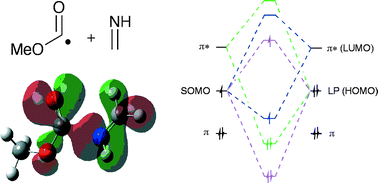Multi-component orbital interactions during oxyacyl radical addition reactions involving imines and electron-rich olefins†
Abstract
Ab initio and DFT calculations reveal that oxyacyl radicals add to

* Corresponding authors
a School of Chemistry, The University of Melbourne, Victoria, Australia
b
Bio21 Molecular Science and Biotechnology Institute, The University of Melbourne, Victoria, Australia
E-mail:
carlhs@unimelb.edu.au
Fax: +61 3 9347 8189
Tel: +61 3 8344 2432
c Department of Chemistry, Graduate School of Science, Osaka Prefecture University, Sakai, Osaka 599-8531, Japan
Ab initio and DFT calculations reveal that oxyacyl radicals add to

 Please wait while we load your content...
Something went wrong. Try again?
Please wait while we load your content...
Something went wrong. Try again?
S. H. Kyne, C. H. Schiesser and H. Matsubara, Org. Biomol. Chem., 2007, 5, 3938 DOI: 10.1039/B714324A
To request permission to reproduce material from this article, please go to the Copyright Clearance Center request page.
If you are an author contributing to an RSC publication, you do not need to request permission provided correct acknowledgement is given.
If you are the author of this article, you do not need to request permission to reproduce figures and diagrams provided correct acknowledgement is given. If you want to reproduce the whole article in a third-party publication (excluding your thesis/dissertation for which permission is not required) please go to the Copyright Clearance Center request page.
Read more about how to correctly acknowledge RSC content.
 Fetching data from CrossRef.
Fetching data from CrossRef.
This may take some time to load.
Loading related content
